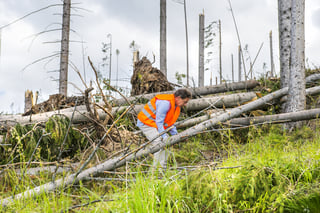Dynamic Risk Assessment: Why Traditional Risk Analysis Isn't Enough
 Lone workers face more risk in the workplace than traditional office employees. Dynamic risk assessment can help these workers stay protected from the unexpected.
Lone workers face more risk in the workplace than traditional office employees. Dynamic risk assessment can help these workers stay protected from the unexpected.
According to the National Safety Council, a worker is injured on the job every seven seconds in the U.S. The top five industries most affected by workplace injuries are service (firefighters and police officers), transportation and shipping, manufacturing and production, maintenance and repair, and construction. It’s no coincidence that these industries call for large numbers of lone workers, who face a wide range of hazards and risks on a daily basis.
Unlike workers in traditional office environments, lone workers are isolated and work alone, making them more prone to hazards. In industries where some amount of risk is part of the job description, keeping workers safe requires businesses to engage in risk management — a process of identifying and assessing risks associated with a specific job. This practice is especially crucial in the case of lone workers.
Although many companies are required to use traditional risk assessment to provide a broad, objective view of potential problems, this does little to assess the spontaneous dangers of remote, off-site work. The truth is that we operate in a turbulent world, and formal risk analysis cannot account for all potential variables. As such, businesses must adopt dynamic risk assessment (DRA) to protect their lone workers.
What Is Dynamic Risk Assessment?
Dynamic Risk Assessment is a reactive method of risk management. Unlike formal risk analysis, DRA is a situational, continual process that is carried out by a worker rather than an employer.
It is not meant to be a replacement for risk assessment protocols, rather it is designed to enable workers to manage risks in real time. After all, not every hazard can be avoided with static policies.
As an example, a lone worker might be tasked with traveling to a job site alone. When that worker arrives at the destination, there’s a chance they’ll be faced with something that makes them feel uncomfortable. A homeowner might be aggressive, or there may be an unexpected environmental hazard like flooding on the site. These sorts of events cannot be identified ahead of time through formal risk analysis, making it the responsibility of the lone workers to mitigate and react to the risk themselves. If they are trained in dynamic risk assessment, they will likely have the necessary tools to react in a way that keeps them safe.
How to Perform Dynamic Risk Assessment
Dynamic risk assessment may sound a lot like common sense, and to a certain extent, it is. But coaching your workers to develop better instincts for potential emergencies is vital, and DRA can provide a simple framework for workers in tough situations.
1. Assess the Environment
Lone workers should begin assessing a situation even before they enter a new environment. For example, a social worker visiting a home should keep an eye out for any signs of aggression or evidence of drugs. If they feel uncomfortable after evaluating the scene, it’s important to leave promptly to avoid a potential incident.
2. Have an Exit Strategy
In the event that a worker deems a location unsafe, they must have a clear exit strategy to evacuate quickly. It’s advisable to always make mental notes of where the doors or emergency exits are. It’s perfectly okay to make up an excuse to leave if necessary.
3. Trust Your Instincts
Lone workers should be trained to trust their “gut feeling” if they develop a sense that something doesn’t feel safe. By coaching employees to be confident in their instincts, businesses can help avoid cases where employees get “too deep” into a bad situation.
4. Document Everything
After a site visit, it’s important to document any notable events for future review and safety planning purposes. This can help other lone workers be prepared in similar situations. This should be a formal policy that is enforced by management.
Implementing an Alert System
While DRA is a useful tactic for lone workers to prepare for potential emergencies, it cannot protect workers without the proper tools. Businesses must pair DRA with alarm systems to ensure their workers have a fail-safe in case of emergencies. This is where Turn-key Technologies’ (TTI) Guardian system can help.
TTI Guardian is a simple and cost-effective wireless communications solution. It offers the flexibility and reliability your lone workers need to work safely in isolated environments. TTI Guardian offers multiple alarm options so that it can be tailored to the specific needs of your lone workers. With nearly three decades of experience in workplace security and protection, our team has the experience, resources, and technology that employers need to keep their lone workers safe.




